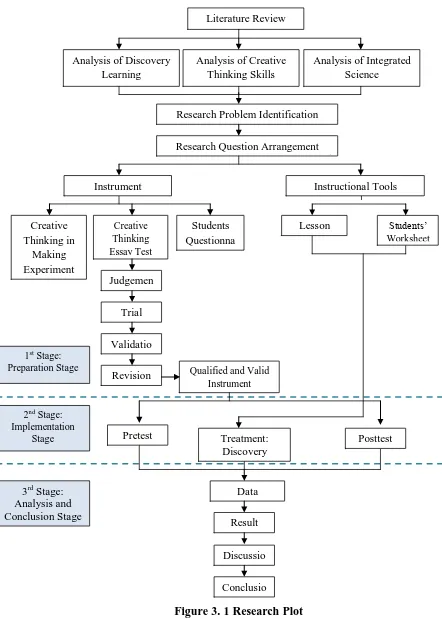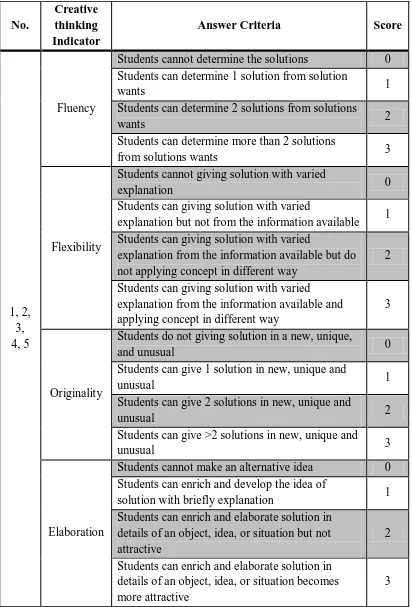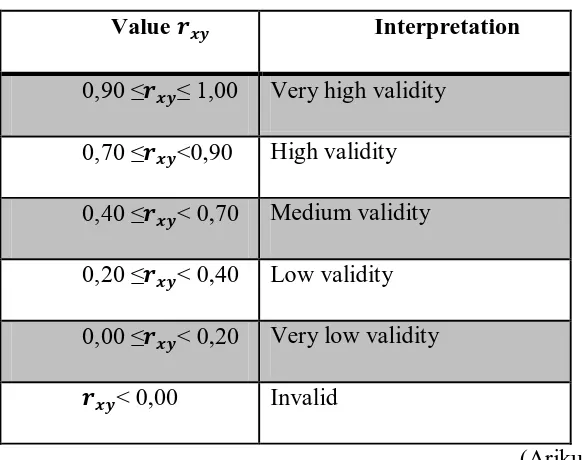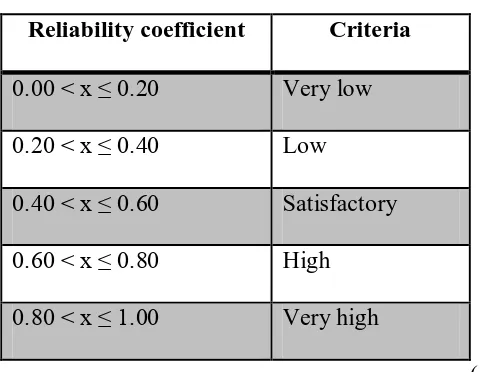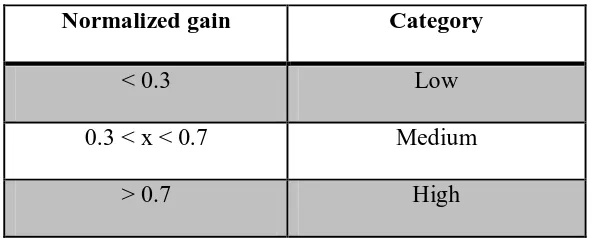CHAPTER III
METHODOLOGY
A. Research Method and Design
1. Research Method
Research methods used in this study is weak-experiment. This
study aimed to obtain information are estimates the information that
can be obtained by actual experiment in a state that does not allow to
control or manipulate all relevant variables.
2. Research Design
The research design used was a one-group pretest-posttest design.
Scheme one group pretest-posttest design is shown as follows:
Table 3.1 Table of Research Design of One Group Pretest and
Posttest Design
Group Pretest Treatment Posttest
Experimental O1 T O2
Note:
O1: Pretest
O2: Posttest
The table explains that the class subject to the pretest (O1) to
measure creative thinking skills. Then students are given treatment in
the form of learning with discovery learning models. After that,
student was given the posttest (O2) with the same instrument with the
pretest. Instrument used as a pretest and posttest in this study is an
instrument to measure the creative thinking skills in learning integrated
science that has been tested and prior judgment.
B. Research Subject
1. Research Location
This research is conducted in one of Public School in Cimahi
which applied National Curriculum 2006 in the teaching and learning
process. The data collection was done in May 2014.
2. Population and sample
The population in this research was 7th Grade Junior High
School students in one of the Cimahi Public School year 2013/2014.
After observation, the sample was taken one class in the seventh grade,
which is VII-2.
C. Assumption
Discovery learning model is a learning model that allows it to be
describes creativity is defined as a cognitive activity that results in a new
way or something in looking at a problem or situation. This result has
same expectation in discovery learning, Zemelman, Daniels, and Hyde
(1993) in Alfian (2011) stated that learning in all subject areas involves
inventing and constructing new ideas. Both expectation results in learning
are can produce new idea in thinking.
D. Hypothesis
The hypotheses in this research are two hypotheses. The explanation is
like below:
H0 : Through discovery learning strategy, there is no enhancing in
students’ creative thinking skills in learning integrated science.
H1 : Through discovery learning strategy, students can enhance their
creative thinking skills in learning integrated science.
E. Research Procedures
There are several procedures that are conducted in this research.
Therefore, the procedure is generally classified into three stages
which are preparation stage, implementation stage, and analysis and
conclusion stage. Each of stage consists of several activities which
1. Preparation Stage
The steps are including the following activities below:
a) Literature review was conducted in analyzing the
information about: 1) Discovery learning, 2) Creative
Thinking Skills, and 3) Integrated science.
b) As the result of literature review, research problem is
identified and elaborated into several research questions
arranged. In order to answering research questions,
instruments were arranged as tools to obtain data.
Arrangement of instrument arrangement including: 1)
Creative thinking in Making Experiment Test, 2) Creative
thinking skills essay test, 3) Observation sheet, and 4)
Students’ questionnaire. Instructional tools which used are
lesson plan and worksheet was arranged to help the
implementation of Discovery learning.
c) Judgment of instruments was conducted by experts.
d) Trial test of creative thinking skill essay test instrument was
conducted to identify the quality of instrument.
e) The result of problem solving test trial was analyzed.
f) Revision of instruments was done based on judgment result
2. Implementation Stage
These activities below are conducted in the implementation
stage which consists of four main activities. The activities are:
a) Pre-test was conducted to identify students’ preliminary
skills
b) Treatment was conducted in four meetings as follow:
1st meeting: Discussion about the topic
2nd meeting: Experimental designing
3rd meeting: Doing the experiment
4th meeting: Presentation, and developing problem
c) Post-test was conducted
3. Analysis and Conclusion Stage
Analysis and conclusion stages consist of four stages, as follows:
a) All of data which is obtained was calculated
b) The result of data calculation was analyzed
c) Discussion was done to elaborate the result of analysis
d) Conclusion was obtained based on the result
In a way of analyzing the plot of the procedures above, it is
represented in the following chart which illustrates the framework of
F. Instructional Tools
Instructional Tools that is used in the implementation of this
research as follows:
1. Lesson Plan
Lesson plan is the design of instructional arrangement that
will be used in the class implementation. The arrangement of
lesson plan refers to the syntax of Discovery Learning which is
proposed by Castronova (2002) in Balim (2009). There are mainly
three syntaxes that should be conducted in the implementation of
Discovery learning in the class activity which are Discussion,
Process, and Developing Problem. However, the implementation
of problem based experiments in this research is arranged
divided into four meetings.
2. Students’ Worksheet
Students’ Worksheet is the additional tools that helps
the implementation of lesson plan in real activity. Students’
worksheet is used as students’ guidance during experiments. The
module consists of the question and problem that should be solved
by students.
Students worksheet consist of both group and individual
worksheets which respectively arranged based on syntax of
discovery learning and the scope of learning objective in
G. Research Instruments
The instrument that is used in this research is test and non-test.
Because this research wants to observe the students’ creative thinking
skills then the test item that be used in essay test.
1. Creative Thinking Skills Tests
Creative thinking is the ability to find some new links, in
looking at the subject from a new perspective and create new
combinations from several ideas, products, colors, textures, and
other things.
Essay tests have been given are pre and posttest
individually. The pretest has been given before the treatment and
the posttest has been given after the treatment.
There will be such indicators in observation sheet to
measure students’ creative thinking skills such as Fluently,
Flexibility, Originality, and Elaboration. Energy in integrated way
is a topic to be raised during designing experiment and having
essay test.
In general, the rubric of creative thinking of essay test
regarding to the aspect and its behavior is described in the table
Table 3.2 Blueprint of Creative Thinking Test Rubric Scoring
Students cannot determine the solutions 0 Students can determine 1 solution from solution
wants 1
Students can determine 2 solutions from solutions
wants 2
Students can determine more than 2 solutions
from solutions wants 3
Flexibility
Students cannot giving solution with varied
explanation 0
Students can giving solution with varied
explanation but not from the information available 1 Students can giving solution with varied
explanation from the information available but do not applying concept in different way
2
Students can giving solution with varied explanation from the information available and applying concept in different way
3
Originality
Students do not giving solution in a new, unique,
and unusual 0
Students can give 1 solution in new, unique and
unusual 1
Students can give 2 solutions in new, unique and
unusual 2
Students can give >2 solutions in new, unique and
unusual 3
Elaboration
Students cannot make an alternative idea 0 Students can enrich and develop the idea of
solution with briefly explanation 1
Students can enrich and elaborate solution in details of an object, idea, or situation but not attractive
2
Students can enrich and elaborate solution in details of an object, idea, or situation becomes more attractive
2. Observation Rubric
The analysis of teacher and students’ activity is conducted
to identify the quality of implementation which is observed from
teacher’s activity coherence with the procedure of Discovery
learning treatment which has been arranged before. In obtaining
data, observation rubrics of students and teacher activity were
arranged. The arrangement of observation rubrics is in line with
procedure of discovery learning and teaching and learning
activities arranged in lesson plan. Observation rubric as
completed by observer which have obligation to analyze and
observe the whole implementation and judge whether the
implementation is in line with the procedure of discovery learning
or not.
H. Instrument Development
Before giving treatment to the experiment class, another class is
used as the trial class to test the instrument should be done first, and then it
has to be analyzed. According to Suherman (2003), it is explained that
qualified instrument of evaluation requires some criteria. These criteria
are to measure the quality of test item and to identified by concerning
the following criteria, such as: validity, reliability, objectivity, practibility,
efficiency. As the form of instrument used is in essay form, thus the
calculation is only done to identify validity, reliability, difficulty index,
and readibility. The more explanation explained below:
1. Validity is the ability of an instrument to measure what is
measured. According to Sudjana (2009) in Nugroho (2013),
validity test which is used in this research is content validity, which
is related to the ability of assessment tool to measure what should
be measured. To measure the validity of each test items are using
this formula:
= − 2− 2 2− 2
(Sudjana, 2005; in Nugroho, 2013)
: correlation coefficient between x and y variable
n : amount of student
x : total score in test item
y : total score of student
While the interpretation about will be categorize based on
Table 3.3 Classification Validity Coefficient
Value � Interpretation
0,90 ≤� ≤ 1,00 Very high validity
0,70 ≤� <0,90 High validity
0,40 ≤� < 0,70 Medium validity
0,20 ≤� < 0,40 Low validity
0,00 ≤� < 0,20 Very low validity
� < 0,00 Invalid
(Arikunto, 2009)
In this research, because the instrument is using essay test,
it should be validated by the expert. After judged by the expert,
trial test to measure realibility, difficulty index, and discriminating
power can be conducted.
2. Reliability test
Reliability is the degree of consistency and stability of the
instrument. Thus, the concept of reliability has the meaning
where the research tools is consistence and stable, and hence
predictable and accurate. KR 20 equation is used to calculate
reliability of the test and the equation is (Arikunto, 2009):
(Arikunto, 2009)
r11 = ( �
r11 : Instrument reliability
k : Amount of test item
∑pq : Multiplication result of p and q
s : Deviation standard
While the interpretation about will be categorized based
on Guilford (Arikunto, 2009) as follow:
Table 3.4 Reliability Value of Question
Reliability coefficient Criteria
0.00 < x ≤ 0.20 Very low
0.20 < x ≤ 0.40 Low
0.40 < x ≤ 0.60 Satisfactory
0.60 < x ≤ 0.80 High
0.80 < x ≤ 1.00 Very high
(Arikunto, 2009)
3. Difficulty Level
A good test item is neither too easy nor too difficult. A
scale that shows the difficulty level of test item is difficulty index
(Arikunto, 2009). The equation which is used to calculate the
difficulty level is:
(Arikunto, 2009)
P : Difficulty index
B : Amount of student who answer question with the right answer
JS : Total amount of students who undertakes the test
Table 3.5 Criteria of Difficulty Level
P Value Category of test
P > 0.7 Very Easy
0.3 ≥ P ≥ 0.7 Medium
P < 0.3 Difficult
(Arikunto, 2009)
4. Discriminating power
Discriminating power of test item is the ability of test item
to differentiate between high achiever and low achiever (Arikunto,
2009). To determine discriminating power of test item, the
equation below is used:
(Arikunto, 2009)
D : Discriminating power
JA : Amount of high achiever
JB : Amount of low achiever
BA : Amount of high achiever who answers question with the right
answer
BB : Amount of low achiever who answers question with the right
answer
D = BA
JA
- BB
JB
PA : Proportion of high achiever who answers question with the
right answer
PB : Proportion of low achiever who answers question with the
right answer
Table 3.6 Criteria of Test Item Discriminating Power
Discriminating power
interval
Criteria of
discriminating power
Negative
Test item is not
appropriate
0.00 < x ≤ 0.20 Poor
0.21 < x ≤ 0.40 Satisfactory
0.41 < x ≤ 0.70 Good
0.71 < x ≤ 1.00 Excellent
(Arikunto, 2009)
In identifying the quality of problem solving test, instrument a
trial was conducted by applying the test into 32 samples 7th grade of
students which already learnt about energy topics. The calculation of
item test analysis was helped by using software Anates 4.0. In summary,
the result of creative thinking analysis test is presented in the following
Table 3.7 Recap Data of Instrument Analysis Result
Item
test
Discrimination
power
Difficulty Index Validity
Conclusion
Value Category Value Category Value Category
1 0.15 Poor 63.43 Medium 0.59 Significant Revised
2 0.17 Poor 38.43 Medium 0.66 Significant Revised
3 0.2 Poor 30.56 Easy 0.61 Significant Revised
4 0.2 Poor 33.33 Medium 0.61 Significant Revised
5 0.12 Poor 23.15 Difficult 0.56
Not
significant
Revised
I. Data Analysis
1) Item Test Data Instrument Analysis
Before the instrument is used in a class about the research
sample, at first the researcher has to test the instrument. The aim is to
determine the accuracy and feasibility of the instrument in measuring
the variables studied.
2) Creative Thinking Data Instrument Analysis
Here are the steps to process the instrument to measure students’
creative thinking according to Nurmaulana (2010):
a) Counting the number of correct scores each item on which
b) Convert the raw scores obtained by students in the form of a
percentage. The following formula is used:
NP = 100%
(Purwanto, 2006: 102; in Nurmaulan, 2010)
Description:
NP: percentage of the expected value
R: crude score gained students
Sm: ideal maximum score of the test in question
c) To view the categories used creative thinking ability according
Arikunto category (2007). The ability to scale categories can
be seen in the following table 3.7:
Table 3.8 Creative Thinking Skills Category
Category Score (%)
Very good 81-100
Good 61-80
Enough 41-60
Deficient 21-40
Very deficient 0-20
(Arikunto, 2007; in Nurmaulana, 2010)
3) Improvement test
To know the improvement of the pre-test and post-test
result, the determination of normalized gain index was conducted.
students’ performance in pre-test and post-test (Saraswati, 2013).
The formula used in measuring the normalized gain such as follow:
G = � � � − � � � �
�� � � � − � � � �
(Saraswati, 2013)
Hake (1998) in Saraswati (2013) argues that normalized
gain is divided into several categories; high, medium, and low. For
more detail, the table of categories is explained below:
Table 3.9 The Students’ improvement Category
Normalized gain Category
< 0.3 Low
0.3 < x < 0.7 Medium
> 0.7 High
